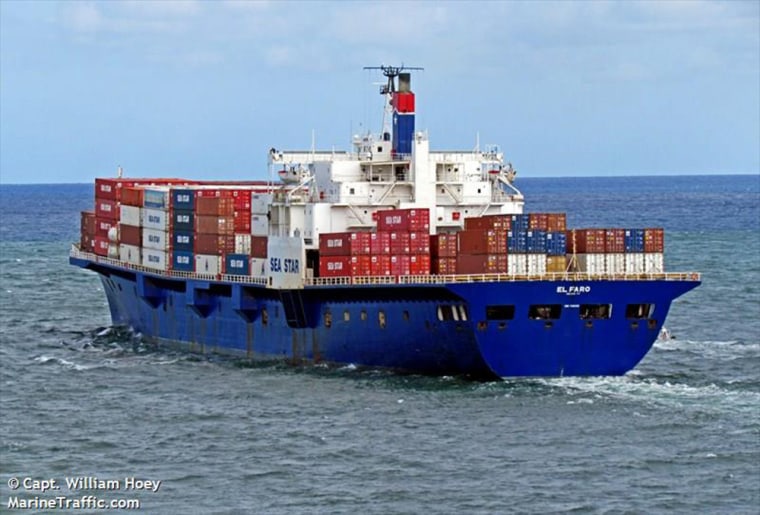The doomed cargo ship El Faro was supposed to have its boilers serviced weeks after it headed out on what turned out to be its final voyage — in which it suffered a "hull breach" and power loss during a hurricane and sank to the bottom of the sea, investigators revealed on Tuesday.
A timeline released by the National Transportation Safety Board said that on Sept. 11, the ship's owner got permission from the Coast Guard to shut down one of the boilers so it could be inspected during a trip. The inspectors then recommended that both be serviced during a drydock scheduled for Nov. 6.
But first, the container-laden ship had to make one more run — from Jacksonville, Florida, to San Juan, Puerto Rico. It departed Sept. 29, hours after forecasters warned that Tropical Storm Joaquin was likely to morph into a hurricane.
Thirty-six hours later, the captain reported an emergency: a hatch had blown and one of the holds was filling with water. The ship had lost its main propulsion unit and engineers could not get it started again, the NTSB said.
"It sounds as though it was a very rapid event," said Marjorie Murtaugh Cooke, former director of the NTSB's Office of Marine Safety who now works for Robson Forensic.
She said that without more information it was difficult to say whether the issue with the boiled played any role in the loss of propulsion, which left the 790-foot ship "dead in the water."
Capt. Bill Doherty, a maritime safety expert at Nexus Consulting Group, said he was floored by the revelation that one boiler had been taken off line and then put back in service just days before the accident.
"Shutting down a boiler at sea in hurricane season is no small thing," he said.
Because of the ship's design, experts said, a breach in the hull could have been catastrophic while the El Faro was stranded.
"When water comes into large open areas on the ship, it's equivalent to trying to walk across the room with a pan full of water," Cooke said. "It will make the vessel unstable."
It's unclear why the hatch — referred to as a "scuttle" of unspecified size in the NTSB report — blew open, but Cooke said if the captain was unable to move the ship, it would have little protection against hurricane-force winds and battering waves.

At the time, the ship was 20 miles from the edge of the hurricane's eye and facing waves of 10 to 12 feet, the captain estimated. After three electronic distress signals, the Coast Guard and the company never heard from the El Faro or its captain again.
"He may have realized very quickly he didn’t have much time and in the time he had, he would take every opportunity to save his vessel, if he could, and certainly his people," Cooke said.
There were 33 crew members on board when it went down in the Atlantic. Last week, the family of one announced plans to file the first of what will likely be a string of lawsuits.
RELATED: Family of El Faro Crew Member Files $100M Lawsuit
The Navy plans to use side-scan sonar and remotely operated vehicles to search the water for the wreck and the voyage data recorder, which could hold crucial clues to why the ship went down.
In its preliminary report, the NTSB said the El Faro had passed its annual Coast Guard inspection in March and another survey in June. Welders and machinists had been making modifications to the vessel before and after — including during the final trip — to prepare for a route change.
Details of those modifications were not included in the report.
